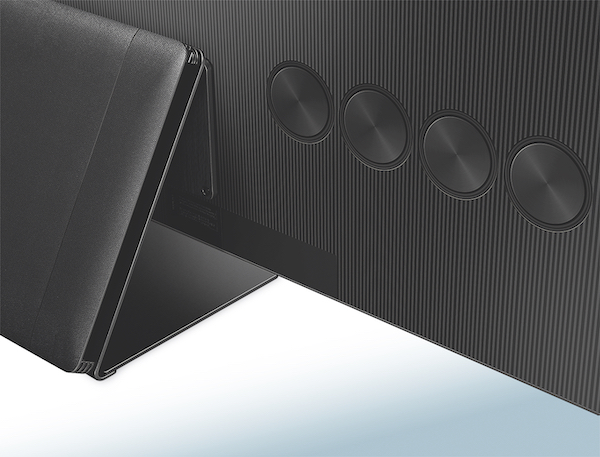Samsung QE65S95C 4K QD OLED TV review

 This second-gen Quantum Dot OLED TV confirms to John Archer that the technology is the real deal
This second-gen Quantum Dot OLED TV confirms to John Archer that the technology is the real dealIt turns out last year's launch of Quantum Dot OLED technology was more significant than we thought. Mixing self-emissive OLED panels with a QD colour layer not only gave us an outstanding new flatscreen option to consider, but ushered in a new period of competition that's already yielding remarkable results in just a single year. It feels as if the premium TV market has been turbo-charged.
The traditional WRGB OLED approach has responded to the QD OLED challenge by introducing new Micro Lens Array technology that ups brightness 30-40 per cent beyond any previous OLED TV. And it's a good job it has, for Samsung's second-generation 65in QD OLED flagship, the QE65S95C, has achieved almost exactly the same sort of brightness increase – and the outcome is every bit as spectacular as you might hope.
Follow-up technology
The 2023 range has also expanded to incorporate premium and entry-level options. Samsung's S90C sets are a few hundred nits less bright than the S95C, carry less powerful sound systems, and sport different, less alluring physical designs. At the time of writing, though, the QE65S90C is available for £600 less than the QE65S95C, so the compromises do come with a substantial saving.
Samsung Display, which manufactures the panels that go into every QD OLED TV from Samsung and Sony, puts the ability of its premium second-generation panels to move up from around 1,000 nits of brightness (measured on a 10% white HDR window) to around 1,400 nits down to two main innovations. First, it has improved the panel's electron transport layer to reduce internal light absorption, so that much more of the light generated by the screens' blue OLEDs finds its way through the red and green Quantum Dot layers and out to your peepers.

New IntelliSense panel-driving software, meanwhile, optimises the way the self-emitted light addresses each pixel, enhancing performance while also, apparently, doubling the panel's long-term reliability by using AI-generated algorithms to spot and compensate for any pixel 'abnormalities'.
If this is as effective as Samsung Display claims, it sounds like a promising attempt to reduce the chance of the TV suffering permanent image retention.
One other massive (literally) QD OLED development for 2023 is the introduction of a new 77in screen size to go with the 55in and 65in models launched last year. There's no indication of a step in the other direction – conventional OLED TVs now begin at 42in – but that's to be expected from such a premium model.
Samsung Electronics has built on Samsung Display's panel improvements with tweaks of its own to its Neural Quantum Processor 4K. Now benefiting from the accumulated results of 20 picture-analysing neural networks, upgrades include better noise detection and reduction (especially during upscaling); a new perceptual colour mapping system that's claimed to deliver more natural and refined colour tones; and a new depth enhancement system that uses object detection and multiple image manipulation techniques to try and present the picture in a more 'lifelike' way.
Slimmed down
The QE65S95C's design swaps the wafer-thin edges but much chunkier mid-rear section of 2022's S95B for a more monolithic design featuring a uniform depth of barely a centimetre, and a rear panel that's almost as flat as the screen.
Unlike LG's flagship G3 OLED, though, the TV ships with a desktop stand. A nice effort it is too, with a reassuringly heavy-duty metal finish and relatively small, central footprint. The neck of the stand also doubles up as a support for the 65S95C's One Connect box, which provides power, picture and sound to the screen through a single light-coloured cable. Connections on the box are exemplary, including four v2.1 HDMIs capable of handling just about anything the latest games consoles and PCs might want to throw at them, including 4K/120Hz, variable refresh rates and HDR.
Other features designed to win over the gaming community are an input lag of just 9.8ms in Game mode; options to increase that lag slightly in return for mild motion processing enhancements; support for ultra-wide PC aspect ratios; and a virtual aiming target.
Smart features are provided by an update to the full-screen Tizen-based platform introduced with mixed results last year. Samsung has improved it, especially when it comes to the usefulness of the content that's highlighted on the home page 'shelves', but it can still feel confusing and illogical at times.

The 65S95C's audio is delivered through a 4.2.2-channel OTS (object tracking sound) system with a driver count including eight units across the rear panel and a number of tweeters ranged around its rear edges. It's complemented by built-in Dolby Atmos decoding, although sadly that's where the Dolby story ends, as Samsung continues not to accommodate the Dolby Vision HDR format on any of its TVs. There's HDR10, HLG and HDR10+ playback, but the askance of DV will be a downer for some Ultra HD Blu-ray enthusiasts.
Let there be light!
The 65S95C's picture quality improvements aren't just instantly apparent; they're instantly game-changing.
The extra luminance visible with both brightness highlights and fullscreen bright content while watching HDR sources is hard to comprehend (though easy to love) in the context of the mere 12 months that have passed since the S95B.
The intense, aggressively mastered day-time desert sequences in Mad Max: Fury Road on 4K Blu-ray erupt from the screen. Even more dramatically, the sort of bright detail and highlighting that's always been OLED's strength is now presented with an unprecedented level of intensity.
This means the extreme contrast on show with some of the space sequences in First Man (4K BD), especially the shot where the moon looms large against the darkness of space through the spaceship window, has never looked more emphatic or, from a TV tech perspective, exciting.
Some LCD TVs, chiefly those equipped with Mini LED lighting systems, might be able to go measurably brighter than the 65S95C – when showing full-screen bright content in particular. But not even the most high-end Mini LED model can manage local contrast down to pixel-level with the accuracy this Samsung set can. Stars, candles, creepy eyes gleaming in the dark... all these smallscale but important movie moments are handled convincingly.
The 65S95C's expanded brightness helps it deliver a huge range and volume of colour. And, yes, the richness of this colour holds good even when the sun is beating down through pristine blue skies onto ...Fury Road scenes packed with flamethrowers, fireworks and gleaming, twisted metal.
Improvements in brightness and colour punch have been achieved without seemingly any detriment to the deep black levels we've come to expect from OLED-based technologies. In fact, the 65S95C's handling of dark scenes shows refinement in a couple of key ways: first to the handling of 'near black' image information, also to video noise in dark scenes. An improved polarising filter on the 65S95C's panel also means black levels aren't nearly as likely to be infused with greyness in bright viewing environments as they were with the S95B.
Samsung's beefed-up Neural Quantum processor clearly has an impact on the sharpness of the 65S95C's pictures. With native 4K material, textural information and subtlety comes without the slightly exaggerated, processed look sometimes witnessed on less refined systems. The improved ability to spot and remove noise in a source, and to discern the difference between real noise and natural film grain, also results in triumphant upscaled HD pictures.
Actually, the improved processing can be felt in almost every facet of the 65S95C's performance. It's a level of single-gen improvement I haven't seen from Samsung since it rolled out its first AI-influenced processor many moons ago, even extending to the audio. Perhaps because of the redesigned bodywork, the 65S95C's speakers provide a far more satisfying blend of power, scale, detailing and, especially, bass than the S95B achieved. It handles Mad Max: Fury Road's suitably furious and effects-packed Dolby Atmos mix with good authority and consistency.
The effectiveness with which the OTS sound system tracks the movement of multiple objects at once around the screen is uncanny at times, helping the TV back up its extra audio 'meat' with a pleasingly busy presentation. This offers at least some compensation for the 65S95C's main fault, which is its sound doesn't push forwards into the room.
Ready for the ride
Other issues with the TV are hard to find. A new HDR
Tone Mapping feature can sometimes be a touch over-enthusiastic with the otherwise most fun Standard picture preset, leading to a slightly strained look to HDR images and a little clipping/desaturating in the brightest areas. Samsung's default motion processing produces very messy results, but can mercifully be 'fixed' by choosing a Custom setting, and setting the de-judder and de-blur processing elements to their three or four levels.
The Standard mode can also suffer with the occasional noticeable jump in baseline brightness during mid-dark scenes, and the unusual triangular arrangement of the 65S95C's subpixels can cause minor green or red object fringing – though you'll typically only be aware of this from a regular viewing distance when viewing small text.
There's nothing in that list of niggles, however, that prevents the 65S95C from being truly, ground-breakingly brilliant. If this is the sort of quality leap we can look forward to across the OLED TV market this year, we're in for one heck of a ride.
HCC Verdict: 5/5
Samsung QE65S95C
Price: £3,599
www.samsung.com
We say: The QE65S95C takes the already great quality of last year's Quantum Dot OLED TV debut and cranks it up more than just a notch. The new-look design is a winner too.
Specifications
4K: Yes. 3,840 x 2,160 HDR: Yes. HDR10, HLG, HDR10+ TUNER: Yes. Freeview HD; Freesat HD CONNECTIONS: 4 x HDMI inputs; 3 x USB; optical digital audio output; Ethernet 4K/120 PLAYBACK: Yes SOUND (CLAIMED): 70W, 4.2.2-channel BRIGHTNESS (CLAIMED): N/A Contrast: N/A DIMENSIONS (OFF STAND): 1,443.5(w) x 829.4(h) x 11(d)mm WEIGHT (OFF STAND): 18.9kg
FEATURES:USB multimedia playback; Wi-Fi; Bluetooth (v5.2); Neural Quantum Processor 4K processing; QD OLED panel technology; Dolby Atmos sound; Object Tracking Sound; 144Hz gaming support; VRR incl. AMD FreeSync Premium Pro; HDMI eARC; wireless (but lossy) Dolby Atmos transmission; Q Symphony sound sharing with compatible Samsung soundbars; HDMI 2.1 on all inputs
 |
Home Cinema Choice #351 is on sale now, featuring: Samsung S95D flagship OLED TV; Ascendo loudspeakers; Pioneer VSA-LX805 AV receiver; UST projector roundup; 2024’s summer movies; Conan 4K; and more
|

















































